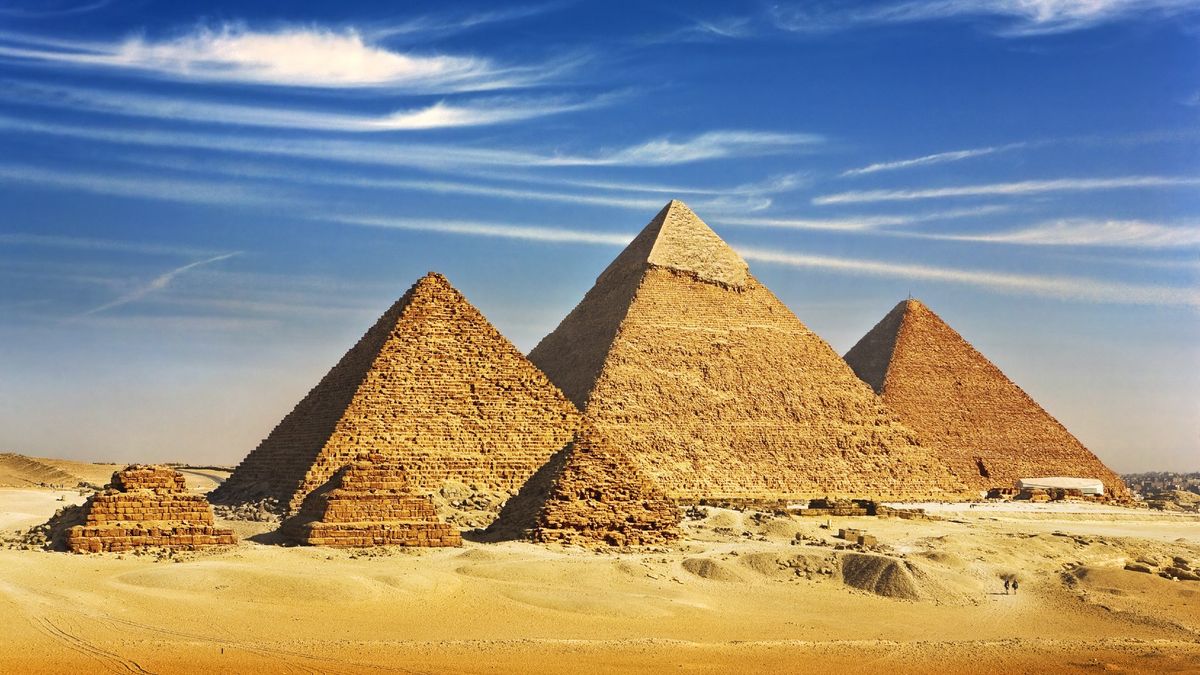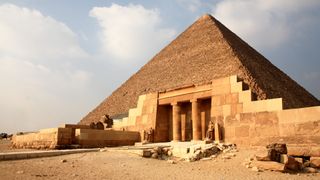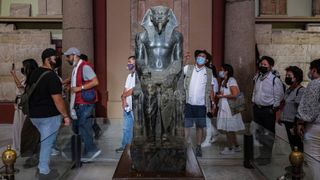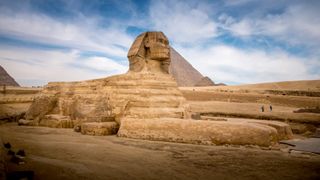Pyramids of Giza and the Sphinx: Facts about the ancient Egyptian monuments
These ancient Egyptian monuments are still a source of speculation and debate.

Constructed in the 26th and 25th centuries B.C. (roughly 2600 B.C.–2400 B.C.), the Egyptian pyramids of Khufu, Khafre and Menkaure, built in that order, are a testament to ancient planning and engineering.
The precise years that they were built is somewhat unclear, as those dates depend on when exactly the pharaohs who built them reigned, which is a subject of debate among scholars. For instance, the Metropolitan Museum of Art dates the reign of Khufu as being ca. 2551–2528 B.C., Khafre as being ca. 2520–2494 B.C. and Menkaure's as being ca. 2490–2472 B.C. However, different sources and scholars have different estimates for when each pharaoh reigned.
How these pyramids were built is also a source of speculation and debate. Many researchers believe that a ramp system of some form was used to move the blocks into place during construction. When the pyramids were completed, they were encased entirely or partly in white limestone, most of which is lost today.
Research suggests that when the blocks were being moved across the desert, a small amount of water was put on the sand in front of them, making them easier to move. In 2018, researchers found a 4,500-year-old contraption in a quarry in the eastern desert that may have been used to help move blocks up a ramp. The contraption has a central ramp flanked by staircases that have numerous post holes on them. A similar contraption could have been used at Giza, researchers said.
Additionally, archaeologists have found evidence that Giza had a bustling port, allowing goods to be shipped to the site from across ancient Egypt and the eastern Mediterranean. Goods brought in included limestone from Tura (a town in Egypt) and cedar wood from Lebanon, researchers have found.
Despite the differences among the three pyramids (Khufu's pyramid, the "Great Pyramid," is several times the mass of Menkaure's) the southeast tips of each pyramid align together almost precisely. Each pyramid had a mortuary and valley temple, with a causeway connecting them. They also had smaller pyramids referred to as satellites or queens' pyramids.
The Sphinx, an enigmatic monument usually associated with king Khafre, stands watch near his valley temple. To the south of the Sphinx is the "Wall of the Crow," which is 656 feet (200 meters) long and 32 feet (10 m) thick.
South of the wall is a settlement that archaeologists sometimes refer to as "the lost city." This city has barracks that may have housed troops, Live Science previously reported. Archaeologists have discovered a mansion in the city that would have been used by senior officials. The pyramid workers may have lived in simpler housing located by the pyramids themselves. Research has also revealed evidence for a massive catering operation that kept people at Giza fed.
Vast cemeteries have also been found beside the Giza pyramids that were in use for thousands of years – long after construction of the pyramids came to an end. Some of the tombs were used for royal family members and senior officials.
In 2018, archaeologists reported finding the 4,300-year-old tomb of a female official. The tomb had wall paintings depicting hunting and fishing scenes, musical and dancing performances, and a pair of monkeys, one of which is dancing in front of an orchestra.
Khufu's Pyramid
When it was completed by Khufu, the Great Pyramid rose 481 feet (146 m). Today, with the loss of some of the stone, the pyramid is slightly shorter, measuring 455 feet (138 m). It was the tallest building in the world until 1311, when the Lincoln Cathedral's central tower was completed in England.
The Great Pyramid is slightly lopsided with the western side being slightly longer than the eastern side. In 2016 it was calculations by engineer Glen Dash and Egyptologist Mark Lehner revealed that the eastern side was originally between 755.561 and 755.817 feet (230.295 to 230.373 meters) while the western side was between 755.833 and 756.024 feet (230.378 to 230.436 m).
To the southeast of the Great Pyramid are three smaller pyramids. Two of them are dedicated to Queen Henutsen and Queen Meritites, who were Khufu's wives, while another small pyramid was dedicated to Queen Hetepheres, who was Khufu's mom, wrote Peter Lacovara, director of the Ancient Egyptian Archaeology and Heritage Fund, in his book "The Pyramids, The Sphinx: Tombs and Temples of Giza" (Bunker Hill Publishing, 2004).
Seven boat pits have been found at Khufu's pyramid, two on the south side, two on the east side, two in between the queens' pyramids and one located beside the mortuary temple and causeway. The best-preserved boat, carefully reassembled from more than 1,200 pieces, is 142 feet (43 m) long, with wooden planks and oars. The purpose of these boats is a mystery.
Khufu's pyramid held three chambers. A grand gallery leads up to the king's chamber, a red granite room that contains a now-empty royal sarcophagus. The king's chamber was protected by a primitive machine that dropped giant blocks in front of the chamber to protect it from grave robbers. Ultimately, at some point in antiquity, people managed to get into the chamber and rob it.
In the center of the pyramid is the so-called queen's chamber, although it probably never held a queen. Beneath the pyramid is a subterranean chamber, its purpose, like the queen's chamber, a mystery.
Both the king's chamber and the queen's chamber each contain two "air shafts" (although they may not have been used as such). The shafts from the king's chamber now lead outside, while the two from the queen's chamber stop after a distance. Robot exploration of the shafts reveal that they lead to doors with copper handles and hieroglyphs.

In 2013 archaeologist Zahi Hawass, the former Egyptian minister of state for antiquities, told Live Science that he believes these shafts lead to Khufu's real burial chamber. "There is no pyramid of the 123 pyramids in Egypt that have these type of doors with copper handles," Hawass said. "Really, I believe they're hiding something."
In 2017, scientists scanned the pyramid using muons — high-energy particles that constantly rain down on Earth. Muons act differently when interacting with different materials (such as stone versus air). With this analysis, the researchers found evidence of a void above the grand gallery that is roughly 98 feet (30 meters) long and 20 feet (6 m) in height. It may contain one or more chambers. They found a second much smaller void beyond the north face of the Great Pyramid.
They detected the voids by analyzing muons A new mission using more powerful muon detectors has been approved, and it may reveal more about what the void contains.
The construction of Khufu's pyramid complex was a massive undertaking. Archaeologist Mark Lehner, who excavates at Giza, estimates that — assuming Khufu reigned for about 30 years — an estimated 251 cubic yards (230 cubic meters) of stone per day had to be put down. That's "a rate of one average-size block every two or three minutes in a ten-hour day," he writes in his book "The Complete Pyramids: Solving the Ancient Mysteries" (Thames & Hudson, 2008), adding that estimates for the average size of these pyramid stones are as high as 2.5 tons.
Scholars are learning more about the workers who built the pyramid. Contrary to popular belief, scholars are confident that the workers who built the pyramids were not slaves. In 2013, an important find was made when the remains of a logbook documenting a group (sometimes translated as a "gang") of workers, led by a man referred to as Merer, was uncovered from the Red Sea site of Wadi al-Jarf.
The logbook mentions that the workers helped transport limestone from Tura to the Great Pyramid. The limestone would have been used in the outer casing of the pyramid. The logbook mentions that this "gang" worked all over Egypt throughout much of the year. Scientists continue to analyze and decipher the logbook, and future work may reveal more about this group of workers who helped to build the Great Pyramid.
Khafre's Pyramid
Khufu's successor, Djedefre, built his pyramid off-site at Abu Roash. The person who succeeded Djedefre, Khafre, returned to Giza and built a pyramid that, today, stands about 446 feet (136 meters) in height, making it somewhat smaller than Khufu's. It was, however, built on a slightly higher elevation making it look taller than that.
Khafre's pyramid would have looked different than that of Khufu's as its outer casing was different. Whereas the casing on Khufu's pyramid was made of limestone the casing on the lower levels of Khafre's pyramid was made of red granite while the upper part was made of limestone, wrote Miroslav Verner, the former director of the Czech Institute of Egyptology, in his book "The Pyramids: The Archaeology and History of Egypt's Iconic Monuments, new and updated edition" (AUC Press, 2021). Most of this red granite casing no longer exists.

Only one satellite pyramid sits outside Khafre's pyramid. Inside, the pyramid's architecture is simpler than Khufu's. It has two entranceways, both on the north side, one located 38 feet (12 m) above the base of the pyramid and another at ground level. "The relatively simple plan of the whole substructure, allow us to conclude that the builders of Khafre's pyramid may have tried to avoid the complications that were encountered in constructing the technically difficult, time consuming, and costly system of passageways, barriers and chambers in Khufu's Pyramid," Verner wrote in his book.
Both entrances lead to passageways that ultimately lead to the burial chamber. That chamber contains a red granite sarcophagus that is empty, with no traces of the mummy or burial equipment found, wrote Verner. They may have been robbed in antiquity.
His valley temple contains a "slightly larger-than-life" statue of Khafre shown sitting on his throne, wrote Jeffrey Newman, a doctoral candidate in Egyptology at UCLA, in an article published on the American Research Center in Egypt's website. Made of a type of volcanic rock called anorthosite gneiss, the statue "is one of the most important and iconic surviving sculptures from ancient Egypt," Newman wrote, noting that the sides of the throne contain hieroglyphs that "represent the king's duty to literally ‘bind' the constituent parts of Egypt together under one authority." The statue is now in the Grand Egyptian Museum.
Menkaure's Pyramid
With a height of 215 feet (65 m) and a base of 335 by 343 feet (102 by 105 m), Menkaure's is by far the smallest of the three pyramids. Lehner notes that its building mass is about one-tenth that of Khufu's pyramid. Its complex includes three satellite pyramids on its south side.
The entranceway for Menkaure's pyramid is located just above ground level, its passages leading to an antechamber and burial chamber. An ornate sarcophagus was found in the 19th century by Howard Vyse, but it was lost when the ship that was taking it to England, the Beatrice, sank.
It's a mystery as to why Menkaure's pyramid is so much smaller than the other two. It could simply be that there wasn't room at Giza for another large pyramid or perhaps events during Menkaure's reign prevented him from building another large structure. No future pharaoh would ever build a pyramid as large as those built by Khufu and Khafre.
The Sphinx

All three of Giza's pyramids had mortuary temples connecting to valley temples through a causeway. However, in the case of Khafre's pyramid, his valley temple also has an enigmatic monument nearby known as the Sphinx, with an uncompleted temple dedicated to it.
The Sphinx is a 241-foot (74 m) long monument carved out of the limestone bedrock of the Giza Plateau. It has the face of a man and the body of a lion. The mythical creature is seen in art throughout the ancient Middle East, as well as in India and Greece. During the spring equinox the sun sets on the shoulder of the sphinx.
The word "sphinx," in Greek can mean "strangler" or "constricted," writes Carolina Lopez Ruiz, a classics professor at The Ohio State University, in an essay published in the book "Text and Intertext in Greek Epic and Drama: Essays in Honor of Margalit Finkelberg" (Routledge, 2020). The face of the giant statue at Giza may have been based on that of Khafre. Efforts to conserve and restore the Sphinx go back at least 3,400 years.
What purpose did the pyramids have?
The simplest explanation for the use of the pyramids is that they were places of burial for their respective kings; the discovery of a sarcophagus in all three pyramids backs up this idea. The pyramid complexes, and the grave goods once located inside them, helped the king ascend to the afterlife.
"The pyramid was supposed to be the death residence of the pharaoh – unshakeable, indestructible, eternal," Verner wrote in his book. He noted that the temple buildings nearby "were dedicated to the worship of the deceased, which was also supposed to go on forever…"
Interestingly, the spiritual importance of Giza appears to cross the ages. In late 2010, archaeologists announced the discovery of the remains of about 400 malnourished people, buried with few grave goods, located near the Wall of the Crow. They date to between 2,700 and 2,000 years ago, two millennia after the pyramids had been built, their burial location suggesting they had a desire to be near Giza.
Today, while people may not worship the pharaohs, the Giza pyramids are a UNESCO world heritage site visited by people from all over the world.
This article was updated on May 6, 2022, by Live Science contributor Owen Jarus.
Additional resources
- Ancient Egypt Research Associates conducts excavations at the Giza plateau, you can learn more about the work they do on their website.
- The Digital Giza project at Harvard also gathers a considerable amount of data on the Giza plateau.
- Scan Pyramids conducted muon analysis of the Great Pyramid and their reports can be accessed on their website.
Bibliography
Jonathan J. Price and Rachel Zelnick-Abramovitz (eds) "Text and Intertext in Greek Epic and Drama: Essays in Honor of Margalit Finkelberg" Routledge, 2020
Lacovara, Peter, "The Pyramids, The Sphinx: Tombs and Temples of Giza" Bunker Hill Publishing, 2004
Lehner, Mark "The Complete Pyramids: Solving the Ancient Mysteries" Thames & Hudson, 2008
Verner, Miroslav "The Pyramids: The Archaeology and History of Egypt's Iconic Monuments, new and updated edition" AUC Press, 2021
Sign up for the Live Science daily newsletter now
Get the world’s most fascinating discoveries delivered straight to your inbox.

Owen Jarus is a regular contributor to Live Science who writes about archaeology and humans' past. He has also written for The Independent (UK), The Canadian Press (CP) and The Associated Press (AP), among others. Owen has a bachelor of arts degree from the University of Toronto and a journalism degree from Ryerson University.












